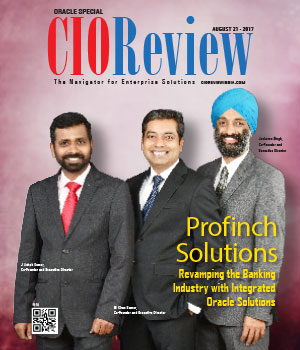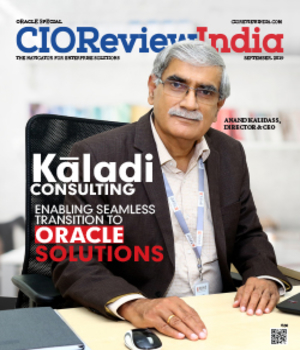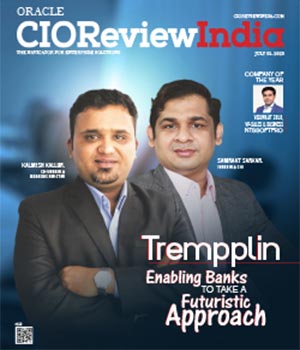
Reaping the Cloud Revolution
Tom Bressie, VP, Cloud IaaS Product Marketing, Oracle
 The Advent of Cloud
The Advent of Cloud
The transformation of enterprise workloads to cloud is one of the most significant IT shifts in recent history. It is changing almost everything about how businesses across industries and geographies use IT to meet their needs.
In making this transition to cloud, the overwhelming majority of businesses don’t have the luxury of starting over with a cloud-first approach. They need to retain focus on serving their customers, and have invested heavily in their existing infrastructures; making the move to cloud potentially quite disruptive. These businesses are seeking a clear path to run existing operations while gradually moving workloads to the cloud.
Circumstances are somewhat different from the vendor perspective– Cloud service providers are shifting as quickly as possible to build solutions that will meet the needs of businesses looking to make the move to the cloud. The new world of IT mixes cloud applications and existing, on-premises applications that interoperate across a hybrid network topology architected according to the needs of the business.
The cloud service providers who will win in this new world of IT will be the ones who can offer flexibility and choice, and can deliver solutions that blend the new cloud model with businesses’ current environments according to their continually evolving needs.
The migration of workloads from traditional on-premises environments to the cloud will happen gradually over time. Businesses have substantial investments in their current application portfolios that will take time to rationalize to a cloud world. Many aren’t eager to scrap their existing way of operating their workloads, but are keen to realize the economic benefits that cloud has to offer. Therein lies the tension that cloud service providers need to help businesses navigate their way through.
Meanwhile, cloud continues to evolve from both a business value and capabilities standpoint. Cloud service catalogs are offering more powerful and use case-specific capabilities and all as infrastructure pricing continues to drop. We also continue to observe many customers looking to take advantage of new opportunities made possible through cloud in areas including the Internet of Things (IoT), machine learning, big data, and artificial intelligence to name a few. Cloud is not only helping transform existing workloads, but also enabling use cases that were previously not possible with existing technologies.
Staying Ahead of the Challenges
Historically, the most common concerns in making the shift to cloud have been security and the governance necessary to verify the integrity of operational security. However, security in the cloud is now quickly becoming a driving factor for cloud adoption rather than a blocker. Attackers are better funded and resourced than ever before, enabling them to outpace the security measures in place in many corporate data center environments. Our internal research indicates that at present, the volume and duration of security breaches in corporate data centers is at an all-time high. Cloud service providers can provide a meaningful solution to the security problem, due to their scale and ability to make substantial investments in people, process and technology.
Another common challenge we observe is a lack of in-house cloud architecture and cloud operations expertise. Businesses need to understand how they will get their existing workloads to the cloud, and what their long-term operating model will be once they go into production. For companies who are considering making this shift for portfolios of thousands of applications, these questions are far from trivial. When you layer on hybrid deployments across multiple different operating models (cloud, dedicated servers, on-premise, off-premise), it quickly becomes clear that teams of cloud experts are required. Cloud service providers would be wise to consider this expertise gap, and build meaningful solutions to help businesses overcome it.
The Changing Role of CIOs
The rise of cloud computing has had a significant impact on how individual business units within the enterprise consume IT. The ‘shadow IT’ issue –the enterprise provisioning and deploying cloud applications outside of the scope of corporate IT -opens up businesses to a myriad of problems. For starters, these applications have the potential to disrupt information security, reliability of business operations, corporate governance, and financial control. It is most often the CIO who is held responsible for any negative outcomes and the first to get the call when something goes wrong.
In addition to managing security risks and reducing costs, CIOs are also being asked to provide a host of new services, such as access to on-demand infrastructure and turnkey developer environments. These capabilities objectively increase the app development agility of the enterprise – but also pose entirely new challenges that CIOs have never faced. In this new world, CIOs have the opportunity to transform the value of their role from just the ‘keeper of the technology’ into a true information leader who enables the enterprise to deliver apps with greater pace and quality than ever before.
Meeting the Diverse Needs
Cloud fundamentally alters what is possible with IT, and enables companies to reimagine what types of solutions they can bring to their customers. Cloud isn’t the end game by itself.
Alongside existing technologies, cloud is quickly becoming a fundamental pillar of the foundation that enables businesses to solve their IT challenges. The ability to quickly gain access to massive amounts of computing power without incurring the extended timelines or massive capital expense of building data centers is a game changer. Through adding cloud infrastructure to their set of available IT solutions, enterprises have the ability to choose the deployment model that meets their highly diverse needs, today and into the future.
Taking the Right Steps
Create and foster an environment of innovation amongst your development teams – encourage and enable them to experiment with the latest advancements in IT. The reality is that your best developers will already be doing this. By creating a partnership with your developers that encourages experimentation with what’s coming next in IT, you will have a better understanding of not only what technologies your developers have a preference for, but also in avoiding ‘shadow IT’ problems.
Many IT decision makers are in the unenviable position of needing both to provide for the day to day as well as having clarity on where their business is heading in the future. This creates a fantastic opportunity for information sharing between businesses who are facing the same types of challenges. Prominent technology conferences can serve as potential opportunities to become acquainted with like-minded business leaders and leverage the collective wisdom of the group to ensure that you stay ahead of the technology curve!
CIO Viewpoint
Why Foolproof Facial Recognition Is Key Against...
By Joseph Sudheer Thumma, Global CEO & MD, Magellanic Cloud
National Technology Day 2025: Powering Progress...
By CIOTech Outlook Team
Aligning IT Roadmap with Business Objectives: A...
By Subhash singh Punjabi, CISO & Head Enterprise Architecture, Deepak Fertilisers & Petrochemicals Corporation Ltd
CXO Insights
Modernizing Enterprise Database Infrastructure...
By Ashish Ray, VP, Mission-Critical Database Technologies, Oracle
Enhanced Database Technology in Business...
By Srikanth Doranadula, Group Vice President-Technology and Systems, Oracle India
ISVs driving the dream of a tech-first world in...









